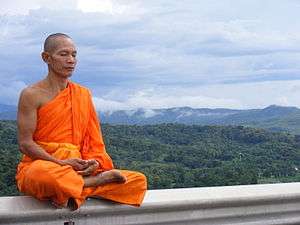Buddhānusmṛti
| Part of a series on |
| Buddhism |
|---|
 |
|
| Part of a series on |
| Mindfulness |
|---|
 |
|
Other |
| Category:Mindfulness |
Buddhānusmṛti (Sanskrit; Pali: buddhānussaṭi), meaning "buddha-mindfulness", is a common Buddhist practice in all Buddhist traditions which involves meditating with a buddha as the meditation subject.
Theravada
In all Theravada countries chanting, devotion (bhatti) and worship (puja) is a big part of lay and monastic Buddhist practice, and devotional chants which praise the qualities of the Buddha are widely used.[1] Buddhānussaṭi is considered one of the four "Guardian meditations",[2] as well as part of the "Ten Recollections" and the "forty meditation subjects" (Kammaṭṭhāna) which also includes recollection of the Dharma, Sangha, morality, generosity and Devas. According to Thanissaro Bhikkhu, recollection of the Buddha is meant to "induce a sense of joy and confidence (pasada) in the practice" that "can bring the mind to concentration and cleanse it of defilement."[3] In the Pali Nikayas' mention of the ten recollections, Buddhānussaṭi is defined thus:
One thing — when developed & pursued — leads solely to disenchantment, to dispassion, to cessation, to stilling, to direct knowledge, to self-awakening, to Unbinding. Which one thing? Recollection of the Buddha. This is one thing that — when developed & pursued — leads solely to disenchantment, to dispassion, to cessation, to stilling, to direct knowledge, to self-awakening, to Unbinding. - AN 1.287-296
The most widely used meditation text in Theravada Buddhism, the Visuddhimagga uses the following 'Buddhānussaṭi Gatha' for contemplation of the Buddha's nine qualities (Nava Guna):
Iti’ pi so bhagava araham sammasambuddho vijjacaranasampanno sugato lokavidu anuttaro purisadammasarathi sattha devamanussanam buddho bhagava’ti."Thus indeed is the Exalted One (1) an accomplished one, (2) a fully-enlightened one, (3) endowed with knowledge and good conduct, (4) well gone or gone to bliss, (5) a knower of the world, (6) an unsurpassed leader of persons to be tamed, (7) a teacher of humans and devas, (8) the awakened or the one who knows, (9) the sublime or exalted."

Buddhagosa's exposition in the Visuddhimagga states that this practice endows one with confidence, mindfulness, understanding and merit. He also states that the practitioner "comes to feel as if he were living in the Master's presence."[4]
According to the 'Netti Sutta' of the Abhidhamma Pitaka a yogin who wishes to practice Buddhānussaṭi can use Buddha statues to practice.[5]
In the Tantric Theravada tradition, practices also include Buddha-mindfulness visualizations. Dhammakaya meditation which was influenced by this Southern tantric tradition, uses the visualization of a clear crystal Buddha image at the center of the body and the repetition of the mantra Sammā-Arahaṃn.
Mahayana

While in Theravada Buddhism, this practice is restricted to Gautama Buddha, in Mahayana Buddhism Buddhānussaṭi and related mindfulness practices are extended to multiple Buddhas and Bodhisattvas such as Maitreya, Avalokiteshvara, Tara and Amitabha. These practices also sometimes involve mental visualization of their physical qualities, bodies and 'Buddha fields'. According to Paul Williams, the development of Mahayana Buddhānussaṭi practices can be traced to the Buddhist meditation teachers of Kashmir who composed several sutras which emphasized mindfulness of Buddhas. One of the earliest sutras which mentions mindfulness of Amitabha Buddha is the Pratyutpanna Samādhi Sūtra (translated into Chinese in 179 CE).[6] This sutra, and others such as the Amitayurdhyana Sutra, include lengthy descriptions of the Buddha Amitabha's physical qualities and of his Pure land which are used in practices that are meant to allow the meditator to access the Pure Land of Sukhavati, worship Amitabha directly and receive teachings from Amitabha.[7] In Pure Land Buddhism this practice is called Nianfo, and the Infinite Life Sutra says that if one practices visualization meditation on the Buddha Amitabha, upon death one will have a vision of Amitabha who will then take them to the Pure Land.[8]
In Vajrayana Buddhism, a tantric type of Buddhānussaṭi is developed in a practice called Deity Yoga (Tibetan: lha'i rnal 'byor; Sanskrit: Devata-yoga) which is classified as an Inner Tantra. The practice of Deity Yoga involves the use of a Mandala image, mantra recitation and visualization of a chosen meditation deity called a Yidam. There are various types of Deity Yoga. One of the practices involves the meditator visualizing the Deity in front of them and another involves the meditator visualizing themselves as their chosen Deity and their surroundings with the elements of their Yidam's Mandala. According to Shangpa Rinpoche, this is the most common type of meditation in Vajrayana Buddhism.[9]
See also
References
- ↑ Ajahn Punnadhammo, Chanting the "Mirror of the Dhamma"; http://www.budsas.org/ebud/ebdha301.htm.
- ↑ U Pandita (2006), The State of Mind Called Beautiful, Boston: Wisdom Publications, page 16.
- ↑ Thanissaro Bhikkhu, A Meditator's Tools A Study Guide on the Ten Recollections, 1999.
- ↑ McMahan, David; Empty Vision: Metaphor and Visionary Imagery in Mahayana Buddhism, RoutledgeCurzon, 2002. pg 149.
- ↑ Angulimalo (2008), Anussati: the Recollections. with Quotes from the Pali Canon and Forest Tradition of Theravada Buddhism, Lulu.com
- ↑ Williams,Paul; Mahayana Buddhism: The Doctrinal Foundations,page 211-212.
- ↑ McMahan, David; Empty Vision: Metaphor and Visionary Imagery in Mahayana Buddhism, pg 150.
- ↑ McMahan, David; Empty Vision: Metaphor and Visionary Imagery in Mahayana Buddhism, pg 151.
- ↑ The Practice of Deity Yoga by Shangpa Rinpoche, http://www.diamondway-buddhism-university.org/en/buddhism/Tibetan_Buddhist_Articles/meditation/diety_yoga.html
External links
| ||||||||||||||||||